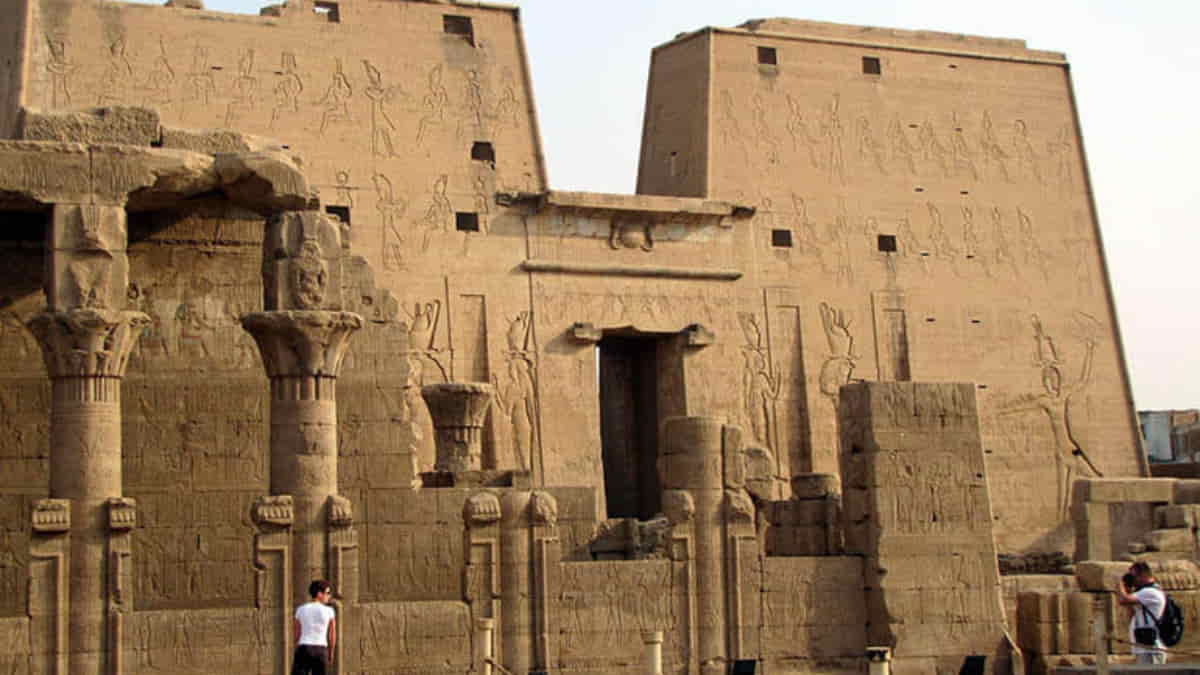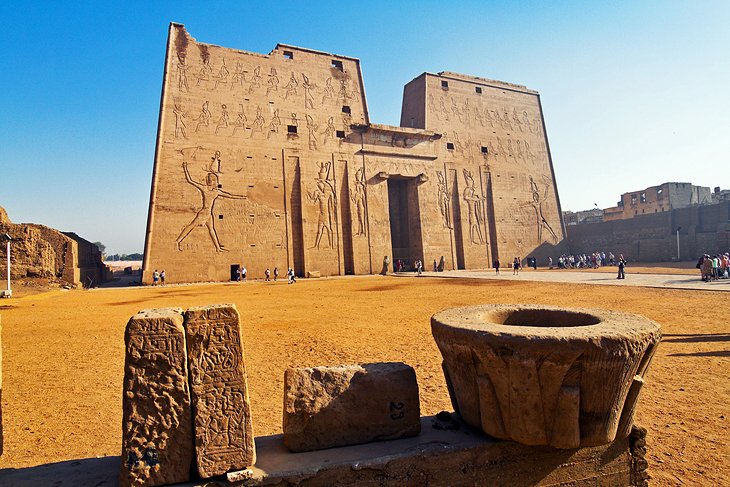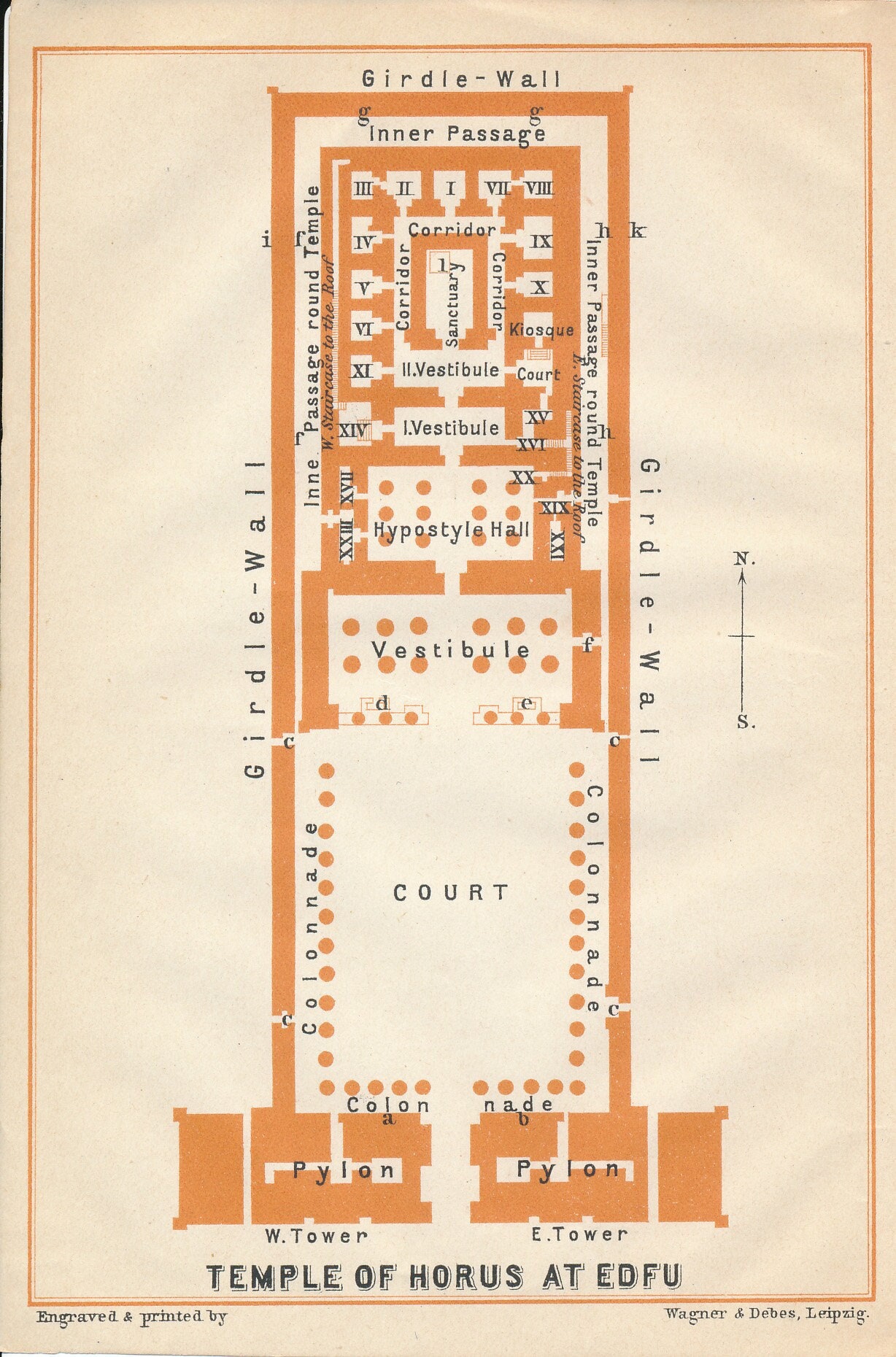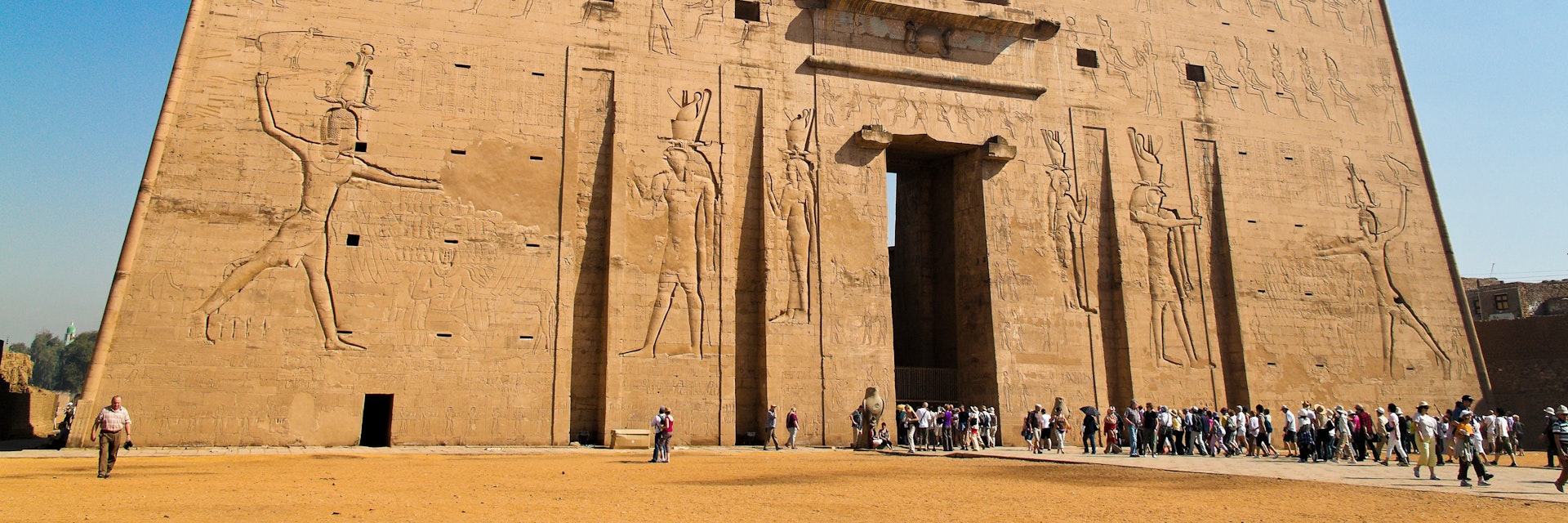A Day at the Temple of Horus at Edfu: A Travelogue
Embark on a journey back in time to the Temple of Horus at Edfu.
This awe-inspiring ancient Egyptian temple, dedicated to the falcon god Horus, offers a glimpse into Egypt's rich and mystical history. As you explore the intricate architecture and immerse yourself in the grandeur of this sacred site, you will be captivated by the stories and legends surrounding it.
Get ready for a day filled with wonder and adventure as you dive into the enchanting world of the Temple of Horus at Edfu.

Overview of the Temple of Horus at Edfu
The Temple of Horus at Edfu is one of the most well-preserved ancient Egyptian temples. It is dedicated to the falcon god Horus and is located near the Nile River in Edfu. This temple is a must-visit for history buffs and travellers interested in ancient Egyptian civilisation.
The temple is known for its impressive size and intricate carvings, which depict various scenes from Egyptian mythology and religious rituals. The temple's architecture is a prime example of the Ptolemaic style, with its massive pylons, courtyards, and hypostyle halls. One of the key attractions of the temple is the central sanctuary, which houses the cult statue of Horus.
Visitors can explore the different sections of the temple, such as the outer and inner halls, chapels, and sanctuaries. Each section showcases different aspects of ancient Egyptian beliefs and practices.
With its rich history and remarkable preservation, the Temple of Horus at Edfu provides a unique glimpse into the ancient world. It is a must-visit for any traveller in Egypt.

Reasons to visit the temple
The Temple of Horus at Edfu is a must-visit destination for travellers in Egypt due to its historical, cultural, and architectural significance. Here are some compelling reasons to include the temple in your travel itinerary:
-
Preservation of Ancient Egyptian Culture: The Temple of Horus is one of the best-preserved ancient temples in Egypt, allowing visitors to experience the grandeur and beauty of Egyptian architecture and mythology.
-
Majestic Architecture: The temple's architectural style, with its towering pylons, intricate reliefs, and imposing columns, showcases the mastery and artistry of ancient Egyptian craftsmen.
-
Cultural and Historical Significance: Dedicated to the falcon god Horus, the temple is closely linked to ancient Egyptian mythology and offers insights into the religious beliefs and practices of the time.
-
Educational Experience: Exploring the temple provides a unique opportunity to learn about the elaborate rituals and ceremonies conducted by the ancient Egyptians.
-
Stunning Wall Carvings: The temple's walls are adorned with captivating and detailed reliefs depicting various scenes from ancient Egyptian life, offering visitors a glimpse into the past.
-
Location: Situated along the Nile River, the temple's location makes it easily accessible for travellers journeying between Luxor and Aswan, making it a convenient stop during your Egypt tour.
Visiting the Temple of Horus at Edfu allows travellers to immerse themselves in Egypt's rich history and gain a deeper appreciation for the ancient civilization that once flourished there.

The Journey to Edfu
Travel options to Edfu
When planning a visit to the Temple of Horus at Edfu, travellers have several travel options to consider. Edfu is located between Luxor and Aswan on the west bank of the Nile River, making it easily accessible from both cities. Here are some popular travel options to reach Edfu:
-
Nile Cruises: Many tourists explore Edfu as part of a Nile River cruise between Luxor and Aswan. These cruises offer a comfortable and scenic journey along the Nile, allowing travellers to visit multiple attractions, including the Temple of Horus.
-
Private Tour: For those who prefer a more personalized experience, hiring a private tour guide and driver is a convenient option. This allows for flexibility in schedule and the opportunity to explore other nearby sites, such as Kom Ombo, on the same day.
-
Public Transportation: Edfu is well-connected by public buses and trains. Travellers can take a local bus or a train from Luxor or Aswan to Edfu. However, checking the schedules in advance is important as they may vary.
-
Taxi or Car Rental: Another option is to hire a taxi or rent a car for a self-guided trip to Edfu. This allows you to explore at your own pace and make additional stops.
No matter which travel option, visiting the Temple of Horus at Edfu is a truly memorable experience that offers a glimpse into ancient Egyptian history and architecture.

Significance of visiting Edfu as part of the journey between Luxor and Aswan
Visiting the Temple of Horus at Edfu as part of the journey between Luxor and Aswan is an essential experience for anyone interested in ancient Egyptian history and architecture. The temple is one of the best-preserved temples in Egypt and offers a unique insight into the pharaohs' rich religious and cultural heritage.
Here are some reasons why visiting Edfu is significant:
-
Historical Importance: The Temple of Horus is dedicated to the falcon god Horus, one of the most important deities in ancient Egyptian mythology. Exploring the temple allows visitors to immerse themselves in the beliefs and rituals of the ancient Egyptians.
-
Architectural Splendor: The temple boasts impressive architectural details, including intricate carvings and towering columns. It is a prime example of the Ptolemaic style of Egyptian temple design and offers a glimpse into ancient Egypt's craftsmanship and engineering skills.
-
Location: Edfu is strategically located between Luxor and Aswan, making it an ideal stop on a Nile River cruise or a road trip through Upper Egypt. Its proximity to other important historical sites, such as Luxor Temple and the Valley of the Kings, adds to its allure.
-
Well-preserved Frescoes: The temple is renowned for its remarkably well-preserved frescoes, which depict scenes from ancient Egyptian mythology and provide valuable insights into the religious practices of the time.
Visiting Edfu as part of the Luxor-Aswan journey is an opportunity to step back in time and marvel at the wonders of ancient Egypt.

Exploring the Temple
Architecture and layout of the temple
The Temple of Horus at Edfu is one of the best-preserved ancient Egyptian temples and showcases the intricate architecture and layout of temples during the Ptolemaic period. The temple follows the traditional Egyptian temple design, consisting of an outer enclosure wall with an entrance gate, a large courtyard, and a sanctuary at the rear.
The entrance gate, known as the pylon, is an impressive structure adorned with intricate carvings and reliefs depicting scenes from ancient Egyptian mythology. Visitors enter the temple through the pylon and are greeted by the spacious courtyard, surrounded by colonnades with beautifully carved columns. The courtyard also houses various chapels and smaller rooms dedicated to different deities.
Moving further into the temple, visitors reach the hypostyle hall, characterized by its rows of towering columns. These columns are intricately decorated with hieroglyphs and reliefs, depicting the battles and victories of Horus. The soaring ceilings and towering columns create a sense of grandeur and awe.
At the temple's rear lies the sanctuary, which houses the cult statue of Horus. This innermost part of the temple was accessible only to high priests and was considered the holiest area. The sanctuary is beautifully decorated with reliefs and carvings, showcasing the devotion and reverence towards the falcon god.
The architecture and layout of the Temple of Horus at Edfu provide a fascinating insight into the skill and craftsmanship of the ancient Egyptians. Its well-preserved state allows visitors to immerse themselves in this iconic temple's rich history and culture.

Key features and highlights of the Temple of Horus
The Temple of Horus at Edfu is one of the most well-preserved ancient Egyptian temples and boasts several key features and highlights that make it a must-visit destination. Standing tall and majestic, the temple's architecture is a testament to the skill and craftsmanship of ancient Egyptian builders.
As you explore the temple, you will encounter the towering entrance pylon adorned with intricate carvings and reliefs depicting battles and religious scenes. The inner courtyard houses a hypostyle hall with towering columns, each intricately decorated with hieroglyphs and colourful reliefs. The sanctuary, dedicated to the falcon god Horus, is the focal point of the temple and houses a beautifully preserved granite statue of the deity.
One of the highlights of the Temple of Horus is the Festival Hall, where important religious ceremonies and rituals take place. The hall's walls are adorned with reliefs illustrating these ceremonies, providing a fascinating glimpse into ancient Egyptian religious practices.
Exploring the Temple of Horus offers a unique opportunity to immerse yourself in ancient Egypt's rich history and mythology. It is an awe-inspiring experience that should not be missed on your journey through Egypt.
History and Mythology
A brief history of the temple's construction
The Temple of Horus at Edfu was constructed during the Ptolemaic period, specifically between 237 and 57 BC. It was built on the site of a much older shrine dedicated to the falcon god Horus, which had been in existence since at least the Old Kingdom period.
The temple's construction was a massive undertaking that lasted for several generations. It required careful planning and coordination to ensure the temple's grandeur and architectural integrity. The temple's layout follows a traditional Egyptian temple design, with a series of pylons, courts, and halls leading to the sanctuary, where the statue of Horus was housed.
The temple faced various challenges during its construction, including political turmoil and changes in ruling dynasties. However, despite these disruptions, the temple was completed and used for centuries.
Today, the Temple of Horus is among the best-preserved and most impressive ancient Egyptian temples. It's construction and exquisite decorations provide invaluable insights into the Ptolemaic period's religious beliefs and architectural achievements. The temple's preservation and restoration efforts ensure that future generations can continue to marvel at its ancient splendour.

Role of the Falcon god Horus in Ancient Egyptian Mythology
The Temple of Horus at Edfu holds significant importance in ancient Egyptian mythology due to its association with the falcon god Horus. In Egyptian mythology, Horus was one of the most important deities, often depicted with the head of a falcon. He was considered the god of the sky, protection, and war. As the son of Osiris and Isis, Horus played a crucial role in the battles against evil forces and symbolized the pharaoh's power and legitimacy.
At the Temple of Horus, visitors can observe numerous depictions and statues representing the god Horus. These include the iconic large stone statue of Horus as a falcon at the sanctuary entrance. The temple also features reliefs and carvings that depict various episodes from Horus' mythological battles, giving visitors a glimpse into ancient Egyptian beliefs and folklore.
Exploring the Temple of Horus provides an opportunity to understand the religious and mythological significance of Horus in ancient Egypt. It allows visitors to witness the ancient Egyptians' deep reverence and worship for this powerful deity and gain insights into the rich cultural heritage of the civilization.

Excavation and Preservation Efforts
Challenges faced during the excavation process
Archaeologists faced numerous challenges during the excavation process of the Temple of Horus at Edfu. The temple was buried under layers of sand and debris for centuries, which made the initial excavation difficult. The accumulation of sand and debris concealed the temple and threatened structural damage.
Another challenge was the delicate nature of the temple's intricate carvings and artworks. The conservation team had to carefully remove the layers of dirt without causing any harm to the delicate reliefs.
Additionally, the temple's location near the Nile River meant the water table was high, resulting in groundwater seeping into the temple's foundation. A comprehensive drainage system was implemented during the excavation process to prevent moisture damage.
Preserving the temple's original colours and pigments on the reliefs proved to be a particularly challenging task. Exposure to sunlight, wind, and sand erosion caused the colours to fade. The conservation team employed advanced techniques to stabilize and protect the remaining pigments, ensuring their longevity.
Despite these challenges, the dedication and expertise of the archaeologists and conservationists involved in the excavation process allowed the Temple of Horus at Edfu to be revealed in all its splendour, offering visitors a glimpse into ancient Egypt's rich history and artistry.

Importance of preserving the temple for future generations
The Temple of Horus at Edfu is an invaluable cultural and historical treasure that must be preserved for future generations. As one of the best-preserved ancient Egyptian temples, it offers a fascinating glimpse into the ancient Egyptians' religious practices and architectural prowess. Preserving the temple ensures that future generations can continue studying and understanding ancient Egypt's rich history and mythology.
By preserving the Temple of Horus, we:
- Protect an important cultural heritage site that showcases the architectural marvels of ancient Egypt.
- Preserve the intricate carvings, reliefs, and hieroglyphics that provide insight into the religious beliefs and rituals of the time.
- Maintain an important historical reference for understanding ancient Egypt's cultural, political, and religious aspects.
- Enable future generations to connect with their past and appreciate the ingenuity and craftsmanship of their ancestors.
- Promote tourism in the region, bringing economic benefits to local communities and encouraging further preservation efforts.
Efforts must be made to conserve and protect the Temple of Horus at Edfu to ensure its longevity and accessibility for future generations to experience and learn from. By implementing proper conservation practices, raising awareness about the importance of preservation, and securing funding for ongoing maintenance, we can ensure that this remarkable piece of history remains intact for years to come.

Visitor Experience
Tips for visiting the Temple of Horus at Edfu
-
Timing: Visit early in the morning or late in the afternoon to avoid the crowds and the scorching midday heat.
-
Dress Code: Wear comfortable, modest clothing that covers your shoulders and knees as a sign of respect. Sunscreen and a hat are also recommended.
-
Guided Tour: Consider hiring a local guide who can provide in-depth knowledge about the temple's history and significance, enhancing your experience.
-
Photography: Bring your camera or smartphone to capture the temple's intricate details and stunning architecture. However, be mindful of the designated no-photography areas.
-
Exploration: Take your time to explore the different sections of the temple, including the Hypostyle Hall, Sanctuary, and the open courtyard. Don't miss the reliefs depicting ancient Egyptian mythology and the well-preserved hieroglyphics.
-
Respect: Remember that the Temple of Horus is not just a tourist attraction but a sacred site. Be respectful of the religious and cultural significance of the temple. Avoid touching ancient surfaces and artefacts.
-
Practicalities: Stay hydrated by carrying a water bottle and consider bringing snacks. Restrooms and refreshment stalls are available nearby.
-
Accessibility: The temple is wheelchair accessible, but some areas may have uneven surfaces. Inform your guide or travel operator in advance to make the necessary arrangements.
Visiting the Temple of Horus at Edfu offers a rare opportunity to immerse yourself in ancient Egyptian history and marvel at its architectural wonders. Take the time to savour the atmosphere and appreciate the rich cultural heritage it represents.

Activities and attractions in the surrounding area
If you're visiting the Temple of Horus at Edfu, there are plenty of activities and attractions in the surrounding area to enhance your experience:
-
Exploring the Town of Edfu: Take some time to wander through the local streets of Edfu and soak in the traditional Egyptian atmosphere. You can interact with friendly local people, visit local markets, and taste delicious Egyptian cuisine.
-
Visit to the Nile: Edfu is located on the banks of the Nile River, so make sure to take a boating trip to experience the beauty of this iconic river. You can enjoy a relaxing felucca ride or take a traditional sailing boat called a dahabiya.
-
Excursion to Kom Ombo: Kom Ombo is another fascinating temple about 45 kilometres north of Edfu. It is dedicated to two gods, Sobek and Horus the Elder, and offers a unique insight into ancient Egyptian religious beliefs.
-
Aswan Day Trip: Edfu is conveniently located between Luxor and Aswan, so you can easily plan a day trip to Aswan to explore its famous attractions like the Philae Temple, the High Dam, and the Unfinished Obelisk.
-
Discovering Luxor: If you haven't already, spend some time in Luxor and explore its ancient sites, including the Karnak Temple, the Valley of the Kings, and the Temple of Hatshepsut.
These activities and attractions add even more depth to your visit to the Temple of Horus at Edfu and provide a well-rounded experience of the rich history and culture of Egypt.
